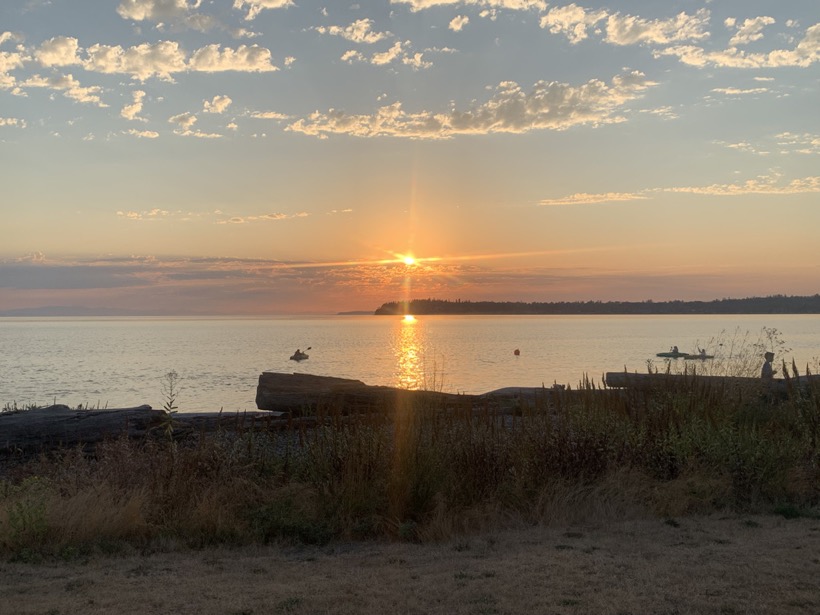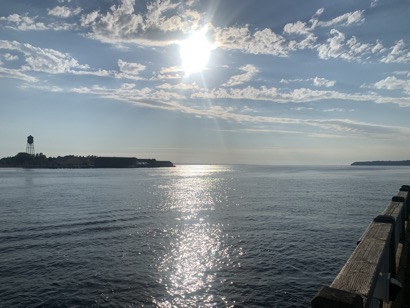Exploring our home
13/08/22 01:34

Although our mailing address is Blaine, we don’t live in the city. We live in a small community outside of the city limits called Birch Bay. From our home we can walk down to the bay and we often walk along Birch Bay. When the weather is warm and the days are long, we frequently walk in the evening when we don’t have evening meetings. Sometimes, however, we go to the village of Blaine to walk. It gives us a different view. Blaine is located on Drayton Harbor, a well-protected inlet. It is also right on the Canadian border. The east-west streets in Blaine are lettered. H Street is sort of the main street of the west side of town and has a bridge over the Interstate to connect with the east side of town. From there, the streets go G, F, E, D, C, B and A as you go north. The next street is 0 Avenue, and is the border. The only north - south streets that cross 0 Avenue are Interstate 5 and Pacific Highway, both of which lead to official border crossing stations at 0 Avenue. Between the border crossing stations there are no fences or official barriers. There is a park next to 0 Avenue and houses on the other side of the street.
I joke that we could walk to Canada from our house. It would be a pretty long walk, since we live 7 miles from Blaine. But once in Blaine, the border is right in town. When we walk along Marine Drive out to the Blaine Public Pier, we can see the the border crossing facilities and the community of White Rock, British Columbia.
The Blaine Pier has a nice park with a playground for children, public boating facilities, including a marina, boat sales and repair facilities and a fish and crab buyer’s facility. There are benches and picnic tables out on the pier and it s a good place to look across the harbor entrance to Semiahmoo Resort, where there used to be fish canneries, and north to Canada. There is a passenger ferry that runs across the harbor entrance connecting the city with the resort. When the canneries were open, it was a way for people to get to and from work in the canneries. Now the ferry is just a tourist attraction, running on the half hour during the afternoon.

When we moved to South Dakota, we moved to a neighborhood that was outside of the city limits. It was a ten mile drive to the church, so we got used to driving. Here we live 20 miles from our church, which is in the city of Bellingham south of our home. We are only working half time, so most weeks we only drive into Bellingham three days. However, because we do make that drive, we tend to shop in Bellingham or in Ferndale, which is a small town between our home and the church. Bellingham is on a large bay with marinas and shipping docks. Lummi Island is just off shore to the west of Bellingham Bay, with the other islands of the San Juans and Vancouver Island, which is in Canadian waters, beyond. Bellingham has a terminal for both the Washington State Ferry and the Alaska State Ferry, carrying cars and people to the islands and north to Alaska.
Living next to the ocean is very different than any other place where we have lived. We grew up next to the mountains. I was used to seeing mountains all around and going to the mountains to hike and to be next to the natural world. Here we aren’t too far from the mountains. We can see Mount Baker clearly from the road as we drive to our son’s farm or to church and we can see Canadian peaks out of our bedroom window. It is a short drive to the high cascades. Mount Baker has snow year round at the top and the national forest and wilderness areas around the North Cascades are full of alpine hiking. Unlike other places we have lived, however, the mountains are to our east. The narrow strip of land between the mountains and the ocean has quite a few people, but we live in a rural area between towns, so don’t feel the urban crush too much unless we need to head farther south to Seattle.
Still in our first year in our new home we have taken to walking along the shore and looking to the ocean for our daily taste of the natural world. As newcomers, there is plenty for us to see. We are learning about tidal rivers and creeks, where the stream flows out to sea at low tide and the ocean flows up the creek at high tide. A creek that changes the direction of its flow multiple times a day is a wonder to us. There are birds and sea animals that are new to us. We’ve seen harbor seals and even whales as we walk along the shore. The gray whales have moved farther north, but they’ll be migrating south in the fall. There are Orcas around the islands that we have seen from boats, but we have not seen Orcas from the shore.
There is something unique about being so close to the boarder as well. It is interesting to us that we can look out and see another country. When we moved, the border was closed to non essential traffic, including tourists, but it is open now and as many as a third of the cars parked along the waterfront sport British Columbia plates.
For now, one of our main recreational activities is exploring this place. Nature has much to reveal to us and we are restored by looking at the vastness of creation. Our pace has slowed a bit, but we continue to be renewed by taking a walk and exploring our world.
